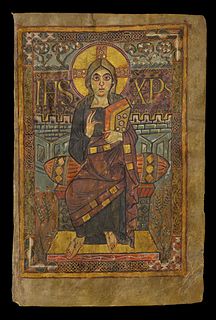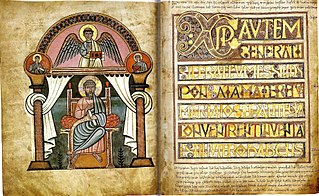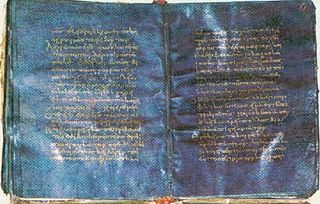
In textual studies, a palimpsest is a manuscript page, either from a scroll or a book, from which the text has been scraped or washed off so that the page can be reused for another document. Parchment was made of lamb, calf, or goat kid skin and was expensive and not readily available, so in the interest of economy a page was often re-used by scraping off the previous writing. In colloquial usage, the term palimpsest is also used in architecture, archaeology and geomorphology to denote an object made or worked upon for one purpose and later reused for another, for example a monumental brass the reverse blank side of which has been re-engraved.

The Rossano Gospels, designated by 042 or Σ, ε 18 (Soden), held at the cathedral of Rossano in Italy, is a 6th-century illuminated manuscript Gospel Book written following the reconquest of the Italian peninsula by the Byzantine Empire. Also known as Codex purpureus Rossanensis due to the reddish-purple appearance of its pages, the codex is one of the oldest surviving illuminated manuscripts of the New Testament. The manuscript is famous for its prefatory cycle of miniatures of subjects from the Life of Christ, arranged in two tiers on the page, sometimes with small Old Testament prophet portraits below, prefiguring and pointing up to events described in the New Testament scene above.

The Ada Gospels is a late eighth century or early ninth century Carolingian gospel book in the Stadtbibliothek, Trier, Germany. The manuscript contains a dedication to Charlemagne's sister Ada, from where it gets its name. The manuscript is written on vellum in Carolingian minuscule. It measures 14.5 by 9.625 inches. The Ada Gospels are one of a group of manuscript illuminations by a circle of scriptoria that represent what modern scholars call the "Ada School". Other products of the Ada School include the Soissons Gospels, Harley Golden Gospels, Godescalc Evangelistary and the Lorsch Gospels; ten manuscripts in total are usually recognised.

The Sinope Gospels, designated by O or 023, ε 21 (Soden), also known as the Codex Sinopensis, is a fragment of a 6th-century illuminated Greek Gospel Book. Along with the Rossano Gospels, the Sinope Gospels has been dated, on the basis of the style of the miniatures, to the mid 6th-century. The Rossano Gospels, however, are considered to be earlier. Like Rossanensis and the Vienna Genesis, the Sinope Gospels are written on purple dyed vellum.

The Godescalc Evangelistary, Godescalc Sacramentary, Godescalc Gospels, or Godescalc Gospel Lectionary is an illuminated manuscript in Latin made by the Frankish scribe Godescalc and today kept in the Bibliothèque nationale de France. It was commissioned by the Carolingian king Charlemagne and his wife Hildegard on October 7, 781 and completed on April 30, 783. The Evangelistary is the earliest known manuscript produced at the scriptorium in Charlemagne's Court School in Aachen. The manuscript was intended to commemorate Charlemagne's march to Italy, his meeting with Pope Adrian I, and the baptism of his son Pepin. The crediting of the work to Godescalc and the details of Charlemagne's march are contained in the manuscript's dedication poem.

The Stockholm Codex Aureus is a Gospel book written in the mid-eighth century in Southumbria, probably in Canterbury, whose decoration combines Insular and Italian elements. Southumbria produced a number of important illuminated manuscripts during the eighth and early ninth centuries, including the Vespasian Psalter, the Stockholm Codex Aureus, three Mercian prayer books, the Tiberius Bede and the British Library's Royal Bible.
The Evangeliary or Book of the Gospels is a liturgical book containing only those portions of the four gospels which are read during Mass or in other public offices of the Church. The corresponding terms in Latin are Evangeliarium and Liber evangeliorum.

A biblical manuscript is any handwritten copy of a portion of the text of the Bible. Biblical manuscripts vary in size from tiny scrolls containing individual verses of the Jewish scriptures to huge polyglot codices containing both the Hebrew Bible (Tanakh) and the New Testament, as well as extracanonical works.

Codex Petropolitanus Purpureus, designated by N or 022, ε 19 (Soden), is a Greek New Testament codex containing the four Gospels. It has been paleographically dated to the 6th century.

Codex Purpureus Beratinus designated by Φ or 043, ε 17, is an uncial illuminated manuscript Gospel book written in Greek. Dated palaeographically to the 6th-century, the manuscript is written in an uncial hand on purple vellum with silver ink. The codex is preserved at the Albanian National Archives in Tirana, Albania. It was formerly possessed by the St. George Church in the town of Berat, Albania, hence the 'Beratinus' appellation.

Uncial 030, designated by siglum U or 030, ε 90, is a Greek uncial manuscript of the New Testament on parchment, dated palaeographically to the 9th century. The manuscript has complex contents, with full marginalia.
Uncial 080, ε 20 (Soden), is a Greek uncial manuscript of the New Testament, dated paleographically to the 6th century.

Minuscule 565, ε 93 (Soden), also known as the Empress Theodora's Codex, is a Greek minuscule manuscript of the New Testament, written on purple parchment, dated palaeographically to the 9th century. It was labelled by Scrivener as 473. The manuscript is lacunose. It has marginalia.

Minuscule 1143, ε 1035, also known as the Beratinus 2, or Codex Aureus Anthimi. It is a Greek minuscule manuscript of the New Testament on purple parchment, dated paleographically to the 9th century. This is one of the seven “purple codices” in the world to have survived to the present day, and one of the two known purple minuscules written with a gold ink.
Uncial 0141, CL13 (Soden), is a Greek uncial manuscript of the New Testament, dated palaeographically to the 10th century.
Lectionary 46, designated by sigla ℓ46, is a Greek manuscript of the New Testament, on purple parchment leaves. Palaeographically, it has been assigned to the 9th-century. It was formerly known as Codex Vindobonensis 2.
The Department of Manuscripts and Rare Books of the Austrian National Library in Vienna was formed in April 2008 by merging the departments of "Manuscripts, Autographs, and Closed Collections" and of "Incunabula, Old and Valuable Books".
The Codex Vindobonensis Lat. 1235, designated by i or 17, is a 6th-century Latin Gospel Book. The manuscript contains 142 folios. The text, written on purple dyed vellum in silver ink, is a version of the old Latin. The Gospels follow in the Western order.
The Codex Vindobonensis 751, also known as the Vienna Boniface Codex, is a ninth-century codex comprising four different manuscripts, the first of which is one of the earliest remaining collections of the correspondence of Saint Boniface. The codex is held in the Austrian National Library in Vienna.













